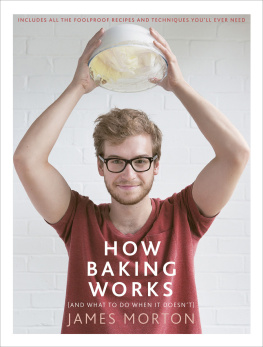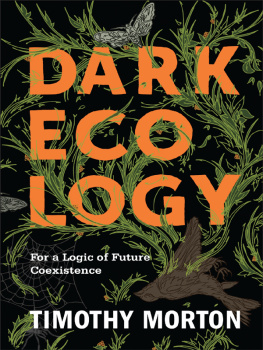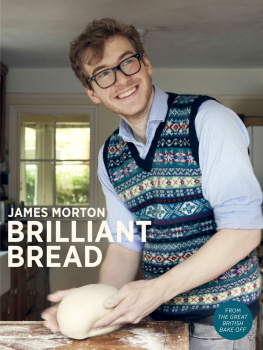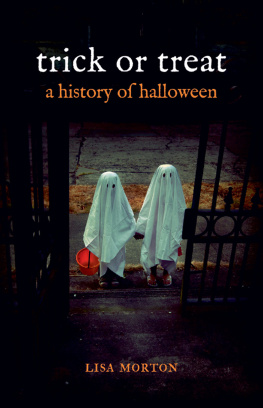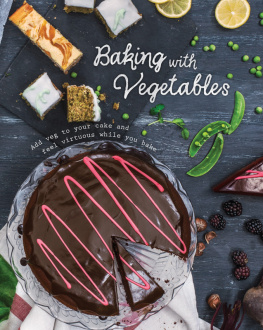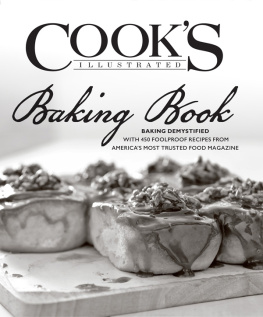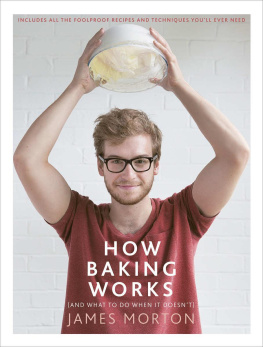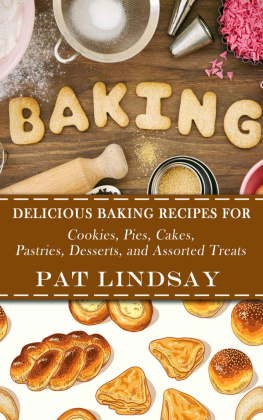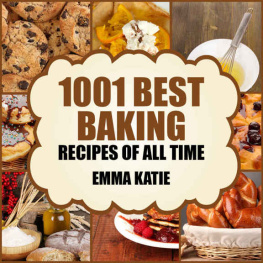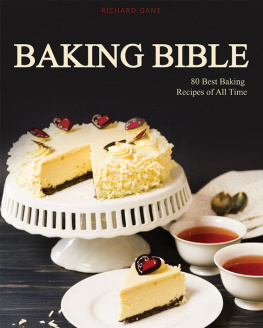Contents
ABOUT THE BOOK
I WANT TO SHOW YOU HOW BAKING WORKS. I WANT TO PROVE HOW EASY BAKING CAN BE.
WHETHER YOU WANT LIGHT CAKES, SQUIDGY BROWNIES, PERFECT PASTRY, STRESS-FREE MACARONS OR MOUNTAINOUS MERINGUES, THIS BOOK FEATURES A MINI-MASTERCLASS FOR EACH ONE.
EVERYTHINGS SPLIT UP INTO WEE, SIMPLE STEPS. THERES NO FAFF AND YOU DONT NEED ANY EXPENSIVE EQUIPMENT. YOU DONT EVEN NEED A SIEVE.
AND FOR YOU BAKING VETERANS, THIS BOOK TELLS YOU WHY YOURE DOING WHAT YOUVE BEEN DOING ALL THESE YEARS.
HERES TO BAKING THAT JUST WORKS.
ABOUT THE AUTHOR
James Morton was runner-up on Great British Bake Off 2012 and loved for his uniquely creative approach to baking. He published his first book, Brilliant Bread, in 2013 which won the Guild of Food Writers Award for Best Cookery Book the following year. Now a qualified medical doctor, James combines imagination and chemistry in his recipe writing, applying an evidence-based approach to baking to dispell unnecessary myths, concoct foolproof recipes, develop techniques that work, and to help as many people as possible become better and more confident bakers. His books are the new classics for the home kitchen and essential to every bakers collection.

This ebook is copyright material and must not be copied, reproduced, transferred, distributed, leased, licensed or publicly performed or used in any way except as specifically permitted in writing by the publishers, as allowed under the terms and conditions under which it was purchased or as strictly permitted by applicable copyright law. Any unauthorized distribution or use of this text may be a direct infringement of the authors and publishers rights and those responsible may be liable in law accordingly.
Version 1.0
Epub ISBN 9781473503106
www.randomhouse.co.uk
10 9 8 7 6 5 4 3 2 1
EBURY PRESS, AN IMPRINT OF EBURY PUBLISHING,
20 VAUXHALL BRIDGE ROAD,
LONDON, SW1V 2SA
EBURY PRESS IS PART OF THE PENGUIN RANDOM HOUSE GROUP OF COMPANIES WHOSE ADDRESSES CAN BE FOUND AT GLOBAL.PENGUINRANDOMHOUSE.COM

PHOTOGRAPHY ANDY SEWELL 2015
COPYRIGHT JAMES MORTON 2015
JAMES MORTON HAS ASSERTED HIS RIGHT TO BE IDENTIFIED AS THE AUTHOR OF THIS WORK IN ACCORDANCE WITH THE COPYRIGHT, DESIGNS AND PATENTS ACT 1988
FIRST PUBLISHED BY EBURY PRESS IN 2015
WWW.EBURYPUBLISHING.CO.UK
A CIP CATALOGUE RECORD FOR THIS BOOK IS AVAILABLE FROM THE BRITISH LIBRARY
PHOTOGRAPHY: ANDY SEWELL
DESIGN: WILL WEBB
STYLIST: LAURA FYFE
COPY EDITOR: RACHEL MALIG
ISBN: 9780091959906
COLOUR REPRODUCTION BYALTAIMAGE
HOW THIS WORKS
This book is for the unpretentious. Everything is simple. Everything is direct. Theres as little useless flowery language as I could muster. Ill remove all the steps you dont need and tell you why you dont need them. I bought every ingredient from my local, medium-sized supermarket.
This book is for everyone who thinks baking should be fun.
This book is for people who want to chuck things in and see what happens. The basics are broken down and explained. Not just the How, but the Why, so youll know exactly what you can change and substitute and switch and what you cant. If anything ever goes wrong, or has ever gone wrong before, well look at what it could be and why it happened and what you can do to stop it ever happening again. This book is for anyone who wants answers. Maybe youve tried to make a macaron and it turned out tasting like porky fish, as mine once did. Or maybe youve had a disaster with choux pastry that somehow turned out both soggy and dry, as mine has done many times. Here are all the answers (I think). And if Ive missed anything, catch me on Twitter and I will find out for you. Im @bakingjames.
Heres to getting it right first time.
HOW TO USE THE BOOK
Like with my first book, Brilliant Bread, Ive refused to conform to the standard 100 or so recipes (of which about three are useful or original) that litter most texts. This project is simply about how to make an awesome cake. Or meringue. Or pie. Or tart. Ill guide you through the basics, then stress what works and what doesnt.
The recipes are mere suggestions.
Go through this book without baking a single one of them and Ill still be delighted (especially if you paid for it). They are designed to help you improve upon your own favourites and to form the foundations of your own creations. If youve got time, please start by taking a look through these first chapters on ingredients and equipment. Especially the ingredients. I believe that knowing a bit about their characters and what you can do to them is imperative to understanding what happens when you combine them in a recipe. Then youll find all the skills and techniques that Ill reference again and again in the recipes: the custards and the ganaches. As well as the routine stuff, like how best to whip cream, use a piping bag or make jam. Then we begin baking. At the start of each chapter, youll find a guide on how to master that particular style, broken down into the following sections.
1. THE IDEAL
This is the necessary opening of each chapter, for it first gives you an idea of what to look for in your final bake. My philosophy on cooking and baking (and pretty much everything creative) is that it doesnt matter which method you use, its your final result that matters. Although a rigid approach could be said to discourage individuality, it shows you what is expected. I baked a tarte Tatin with a soggy bottom for years before realising it wasnt actually supposed to congeal when I chewed it.
2. STEP BY STEP
This section guides you through the processes involved in the creation of a particular dish, stopping short of baking. I will stress how to carry out each step and then break up each one further into tiny wee baby steps. Then Ill explain why were doing what were doing. The deeper you understand something, the less likely you are to forget it.
Sometimes these will be referenced in the other recipes within the chapter. Youll find little variation between bakes the principles and the pitfalls are the same for each one.
3. THE BAKE
The bake itself. I hope the theme across all these sections is one of reiteration. The range of baking times and temperatures is tiny, if you look closely. Pretty much all the recipes in this book are baked within 40 degrees of one another. And the thermostats on many ovens are out by far more than that.
Baking will require a bit of tinkering and getting to know your own oven. Mine has more than 50 degrees of variation, front to back and top to bottom, and it can still turn out a pretty perfect batch of macarons. It just takes a little getting used to.
4. VARIATIONS
This is a short list of variations to the base recipe and when to use them. These are usually just wee additions or recommended replacements, but they can make a big difference. This list is not exhaustive, but it should give you plenty to try. Exponentially more if you combine them.

